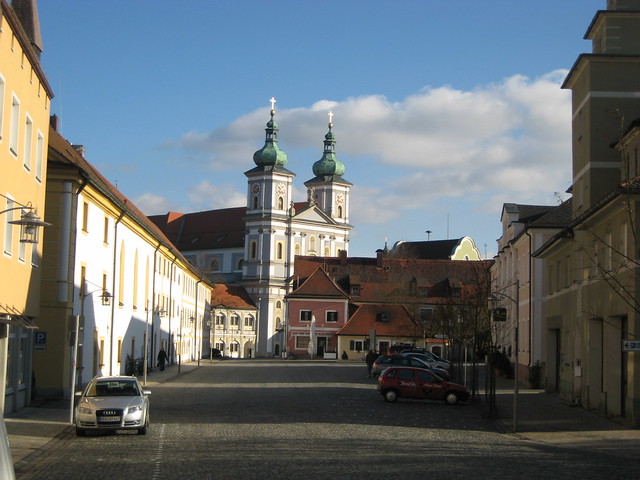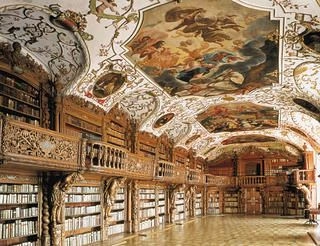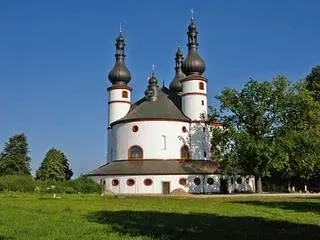Cistercian Monastery with Churches and Library by Georg Dientzenhofer
Baroque churches and monastery library by Georg Dientzenhofer, Carlone, Hofreiter, and Steinfels are the top sights in Waldsassen in the Upper Palatinate, Germany.

The main reason to visit Waldsassen is to see the Cistercian abbey church and library – both are masterpieces of the Bavarian Baroque and Rococo. The Wallfahrtskirche der Heiligsten Dreifaltigkeit (Pilgrim’s Church of the Holy Trinity) just outside Waldsassen is a further popular sightseeing destination.
In 1133, a Cistercian monastery was founded in Waldsassen, the first of this order in Germany. Only during the 17th century did a civilian community developed in the region. The monastery was secularized at the end of the 16th century but reopened after Oberpfalz became part of Bavaria. It closed again in 1803 but reopened in 1864.
Waldsassen Tourist Office
Tourist-Info Waldsassen, Johannisplatz 11, 95652 Waldsassen, tel 09632-88-160.
Most Mondays at 10 am and Fridays at 3 pm, visitors are welcomed in the Waldsassen tourist office with a short video and free glass of Sekt (sparkling wine) or a coffee.
Waldsassen’s Baroque Abbey Basilica and Library
The Stiftsbasilika Waldsassen (Abbey Basilica), Basilikaplatz 6, tel 09632-1387, is a Baroque masterpiece worth a detour. The original church and monastery were severely damaged during the 15th and 16th centuries and almost completely destroyed during the Thirty Years’ War.
Following the return of the Cistercians to Waldsassen in 1661, the decision was taken to rebuild the complex in a Baroque style. The church was designed by Abraham Leuthner, the court architect in Prague, assisted by Georg Dientzenhofer, the eldest of the five talented building master brothers.
The Waldsassen abbey church is typified by its extraordinarily long but narrow nave, the second largest monastery church in old Bavaria. It is 82.7 m/271 ft long but only 13.5 m/44 ft wide and 24 m/79 ft high. The frescoes are by Jakob Steinfels while the opulent stuccowork is mostly the work of Giovanni Battista Carlone, who also worked in the Passau Cathedral. The main organ is from the 1980s and with 103 registers one of the largest in Europe. The crypt, generally not open to the public, runs the full length of the church and is one of the largest in Germany.
The Waldsassen abbey church’s opening hours are daily from 7:30 am to dusk.
At least one concert per month is held in the basilica by visiting musicians while the local chamber musical orchestra also performs frequently at various venues in the region. On some Sundays, free organ matinees are held at 2 pm.
The Bibliotheksaal (Library) at Waldsassen in the Upper Palatinate
In the adjacent Waldsassen monastery, the main sight is the marvelous Bibliotheksaal (Library), Basilikaplatz 2, tel 09632-920-025. It was completed in 1726 and in the transition style from High Baroque to Rococo.
The frescoes of the Waldsassen Library are by Karl Hofreiter but the true artistic highlight is the wood-carved atlantes by Karl Stipt. The symbolism of these 10 almost life-size statues have different interpretations but probably are symbols of weaknesses in human character.
The Waldsassen Monastery library can only be seen on guided tours. It is open daily, November to March from 1 to 4 pm and April to October from 10 am to noon and 2 to 4:45 pm, but closed on Monday mornings. Admission is €2.50.
Wallfahrtskirche der Heiligsten Dreifaltigkeit (Pilgrim’s Church) near Waldsassen
Around 3 km/1.9 miles from Waldsassen is the amazing Wallfahrtskirche der Heiligsten Dreifaltigkeit (Pilgrim’s Church of the Holy Trinity), Kappl, tel 09632/502148, better known simply as the Kapplkirche. The area has been a pilgrimage site since the foundation of the nearby monastery in Waldsassen but several wars and the frequent confession changes forced on Oberpfalz saw the ruin of various chapels.
The present Wallfahrtskirche der Heiligsten Dreifaltigkeit chapel is the work of Georg Dientzenhofer, who worked from 1685 until his death in 1689 on the church in Waldsassen. The chapel was consecrated in 1711, more than 20 years after Dientzenhofer’s death.
As the chapel is dedicated to the Holy Trinity, everything here is in threes: three towers, three vaults, three chapels, and three altars in each chapel. The floor plan is basically a triangle with rounded corners. The interior is bright and gives an impression of space well beyond its actual physical size. The present frescoes were painted during the 1930s by Oskar Martin.
The Wallfahrtskirche der Heiligsten Dreifaltigkeit (Pilgrim’s Church of the Holy Trinity) opening hours are daily from November to March from dawn to dusk and April to October from 8 am to 6 pm. Admission is free.
It is a pleasant hour-long hike from Waldsassen to Kappl – see Countryside Hikes.
Further Destinations in the Oberpfalz / Upper Palatinate:
- Amberg – Old Town and Baroque Churches
- Weiden – Neo-Gothic, Art Nouveau, and the International Ceramics Museum
- Flossenbürg – Concentration Camp Memorial Site where Dietrich Bonnhoefer died
- Waldsassen – Cistercian Monastery Church & Library, and Holy Trinity Chapel
- Outdoor Adventures – Hiking, Cycling, and Canoeing in the Oberpfalz
- Hotels & Restaurants in the Oberpfalz – Including the World’s Smallest Hotel
- Introduction to the Oberpfalz (Upper Palatinate Region in Bavaria)

